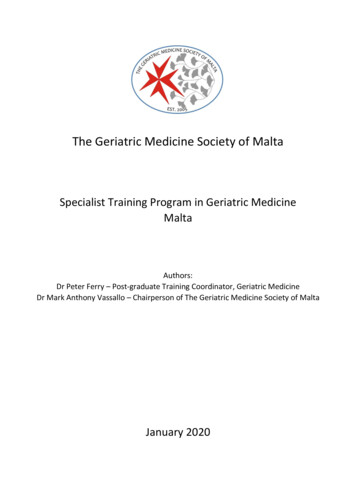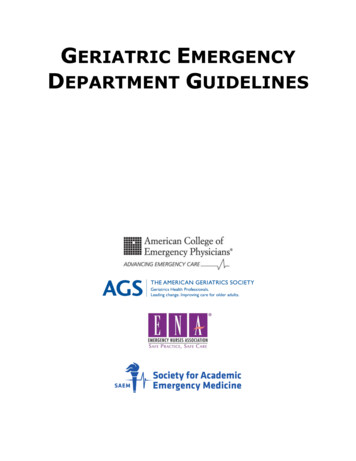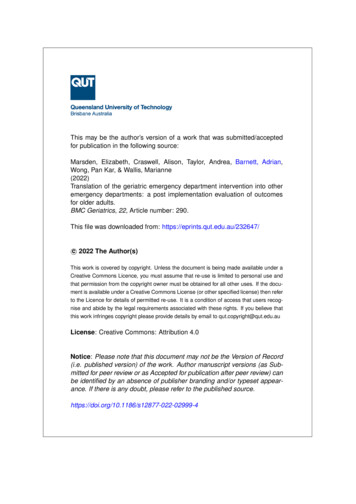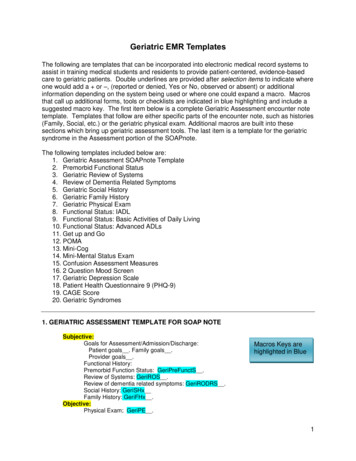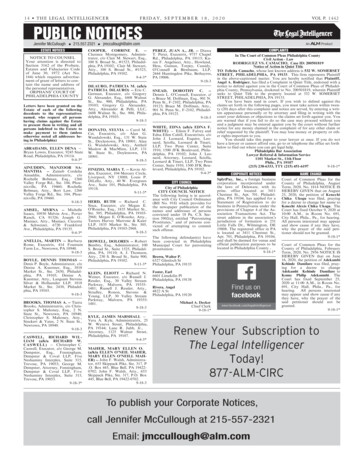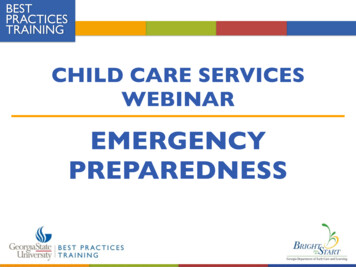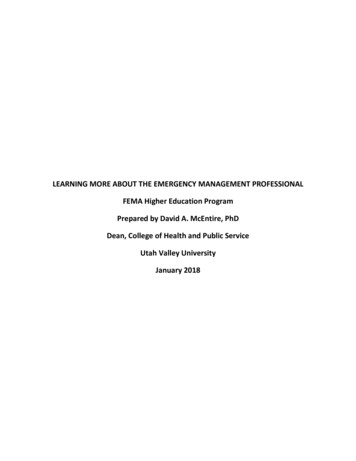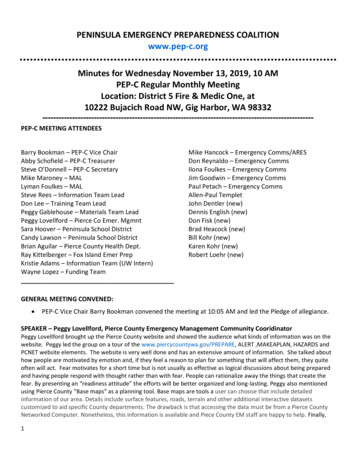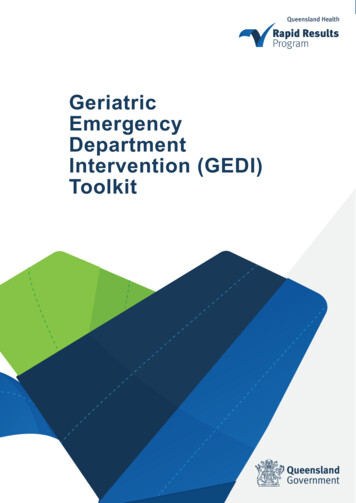
Transcription
GeriatricEmergencyDepartmentIntervention (GEDI)ToolkitGeriatric Emergency Department Intervention (GEDI) ToolkitPage 1 of 86
Doc ID. version000081.02Approved byDate approvedReview dateDirector Emergency Medicine SCHHS16/01/202026/10/2023Endorsed by Queensland EmergencyDepartment Strategic Advisory PanelGeriatric Emergency Department Intervention (GEDI) ToolkitFunding for the Geriatric Emergency Department Intervention (GEDI) Toolkit was provided by both theAustralian and the Queensland Governments. The Care coordination through Emergency Department,Residential Aged Care and Primary Health Collaboration (CEDRiC) project, of which GEDI was a part, wasfunded via an Aged Care Service Improvement and a Healthy Ageing Grant through the CommonwealthDepartment of Social Services and was administered by the Department of Health. The QueenslandHealthcare Improvement Unit also provided funding. In kind salary contributions were also provided by theSunshine Coast Hospital Health Service, and the University of the Sunshine Coast.For further information please contact:The Healthcare Improvement UnitEmail: HIU@health.qld.gov.auWebpage for electronic version: -care-older-queenslandersCopyright The State of Queensland,Sunshine Coast Hospital and Health ServiceUniversity of the Sunshine Coast 2017This document is licensed under a Creative Commons Attribution Non-Commercial No Derivatives 3.0Australia licence. In essence you are free to copy and communicate the work for non-commercial purposes,as long as you attribute the authors and abide by the licence terms. You may not alter or adapt the work inany way.To view a copy of this licence, 3.0/au/deed.enGeriatric Emergency Department Intervention (GEDI) ToolkitPage 2 of 86
About the authorsDr Elizabeth Marsden MBBS FACEMEmergency Physician, GEDI Clinical lead, Sunshine Coast Hospital and Health ServiceAndrea Taylor RNGEDI CNC, Sunshine Coast Hospital and Health ServiceProfessor Marianne Wallis RN PhDProfessor of Nursing, University of the Sunshine CoastDr Alison Craswell RN PhDCEDRiC Project Manager, Research Fellow, University of the Sunshine CoastNicolette Bannink RN MAdvancedNPracResearch Assistant CEDRiC Project, University of the Sunshine CoastDr Marc Broadbent RN PhDSenior Lecturer, University of the Sunshine CoastColleen Johnston RNSenior Research Officer CEDRiC Project, University of the Sunshine CoastAcknowledgementsDevelopment of the GEDI Toolkit was a joint project between SCHHS, USC and the Clinical ExcellenceDivision, Queensland Health. Clinical Excellence Queensland is committed to supporting projects whichdeliver better health outcomes for Queenslanders and provided full funding for the development of this toolkit.The following people are acknowledged for their contributions to this toolkit.Amanda Glenwright RN MHlthMgtRegional Program Coordinator, Central Queensland, Wide Bay and Sunshine Coast PHNKaye Coates RN MNPractStNurse Practitioner, Sundale Ltd.Professor Julia Crilly RN PhDProfessor of Emergency Nursing, Griffith University and Gold Coast HealthCitationThis work should be cited as:Marsden E, Taylor A, Wallis M, Craswell A, Bannink N, Broadbent M & Johnston CM. (2017)Geriatric Emergency Department Intervention (GEDI) Toolkit. Healthcare Improvement Unit:BrisbaneGeriatric Emergency Department Intervention (GEDI) ToolkitPage 3 of 86
ContentsExecutive summary - findings from the research evaluation6Disclaimer6Navigating the toolkit7An overview of the Geriatric Emergency Department Intervention (GEDI)9Background – the clever part9Underpinning principles of the GEDI model – the boring part9Objectives of the GEDI model – the exciting part12The patient journey13Benefits of the GEDI model15How to GEDI: Step 1 - Pre-implementation planning16Identify an ED physician with a passion and interest in aged care to champion change for GEDI 16Identify a Clinical Nurse Consultant16Identify and communicate the need for the GEDI service in your health service17Identify benefits and risks of implementation18GEDI model parameters21Establish governance22Staffing a GEDI service22Train the trainer – for GEDI staff23Care of the older person in emergency module24Identification of frailty24Clinical frailty scale24Decision-making related to care of older persons in the ED26How to GEDI: Step 2 – What the GEDI team does and how they do it27Multidisciplinary team approach27GEDI team clinician roles29GEDI patient screening, assessment, decision-making, advocacy and intervention30Clinical integration with allied health services35Discharge coordination35How to GEDI: Step 3 – GEDI service management35GEDI team involvement in identification of the need for and developing ED specific protocols for thecare of older people in the ED36GEDI clinical expertise – portfolio management36Education and professional development37Embedding GEDI staff and service delivery management within the ED38How to GEDI: Step 4 – GEDI service evaluation for sustainable funding and service delivery39Health service evaluation39Key documentation for evaluating your implementation39Abbreviations45Key health care professional roles for implementing GEDI46Glossary of terms47Appendix A – GEDI CNC job description48Appendix B – Example concept brief of business case pathway49Appendix C – GEDI implementation checklist51Appendix D – Formula for determining GEDI staffing52Appendix E – Equipment53Geriatric Emergency Department Intervention (GEDI) ToolkitPage 4 of 86
Appendix F - Useful websites and geriatric nursing learning modules for further information on thehealthcare needs of the older person54Appendix G – GEDI CN job description56Appendix H – Advantages and disadvantages of using existing ED staff in GEDI roles57Appendix I – Tools for assessing frailty58Appendix J – Additional information on GEDI role descriptions and responsibilities62Appendix K - Examples of potential screening tools67Appendix L – Sample GEDI nurse discharge letter for the GP69Appendix M - GEDI emergency department discharge checklist71Appendix N - 4AT cognitive assessment72Appendix O – Example of dashboard73Appendix P – Sample geriatric assessment instrument dashboard74Appendix Q - ED patient flow analysis example75Appendix R – ICD-10 code mapping77Appendix S – GEDI nurse data collection sheet78Standards and supporting documents79Audit and compliance strategy83References84Geriatric Emergency Department Intervention (GEDI) ToolkitPage 5 of 86
Executive summary - findings from the research evaluationWorldwide, ageing populations are placing increasing pressure on health services for the management ofacute illness and exacerbation of chronic conditions in older persons. In 2015, over 20% of Sunshine Coastresidents were aged 65 years and over compared to 15% in Australia (ABS, 2017). Emergency department(ED) presentations and hospital admissions for older persons is associated with an increased risk ofcomplications compared to younger cohorts (Ackroyd-Stolarz, Read Guernsey, Mackinnon, & Kovacs, 2011;Briggs, Coughlan, Collins, O’Neill, & Kennelly, 2013; Dwyer, Gabbe, Stoelwinder, & Lowthian, 2014; Mudge,Denaro, & O'Rourke, 2012; L. Schnitker, Martin-Khan, Beattie, & Gray, 2011; Schnitker, Beattie, Martin-Khan,Burkett, & Gray, 2016). Appropriate care of this vulnerable cohort is critical to improving care for the olderperson and managing shrinking health dollars.The Geriatric Emergency Department Intervention (GEDI), operating in the ED of Nambour General Hospital,Sunshine Coast Hospital and Health Service (SCHHS), is a service providing specialist and targeted care forpersons aged 70 years and over who present to the ED. The GEDI team comprises of a Clinical NurseConsultant, ED physician and Clinical Nurses providing ‘front load’ assessment within the ED to prioritiseassessment and management of frail older persons. GEDI nurses aim to avoid inappropriate hospitaladmissions of older persons whilst streamlining their care to the right place, right person at the right time. Thisaligns with the Australian Charter of Healthcare Rights (Australian Commission on Safety and Quality inHealthcare, 2008) and SCHHS (2014) purpose “To deliver the highest standards of safe, accessible,sustainable, evidence-based health care with a highly skilled and valued workforce that optimises thewellbeing of our community”. The GEDI model builds upon successful interventions, such as comprehensivegeriatric assessment (Ellis, Marshall, & Ritchie, 2014), by tailoring interventions to the ED environment.The GEDI service was evaluated utilising the Donabedian (2003) Structure, Process and Outcome framework.Data on the GEDI model were collected over a 12-month period from September 2015 to August 2016. Thisdata was compared with historical outcome data from the pre-GEDI period January until December 2012 andthe interim GEDI period, January 2013 through until August 2015. Outcome measures included disposition,ED length of stay, hospital length of stay and re-presentation to 28 days. Qualitative data to understandstructure and processes of the GEDI service were collected from interviews with GEDI patients, families orcarers and ED staff.The older person cohort in this evaluative research study were on average 81 years of age, 50-52% beingfemale across all three data collection periods. The results of the data analysis indicated that older personswho presented to the ED during the full GEDI intervention period benefited with statistically significantreduction in ED length of stay and increased likelihood of discharge compared to pre-GEDI. No significantdifference in risk of mortality or risk of same cause representation to 28 days was found. Reductions in lengthof stay and increased rate of discharge resulted in average cost savings per ED presentation of 35 [95% CI: 21, 49] and savings of 1,469 [95% CI: 1,105, 1,834] per hospital admission. Aggregated data frominterviews with seven GEDI patients, families and carers and 23 staff determined that the service has becomean integral part of ED patient care, it facilitates efficient time management with better patient and staffsatisfaction. The Geriatric Emergency Department Intervention is highly successful in improving the care ofolder persons in the ED.DisclaimerIt is important to note that activities being undertaken through this project are not the only factors in influencingand impacting on the delivery of ED care of older persons. The outcomes described will also be influenced tosome degree by other initiatives being undertaken at a state wide and local HHS level to improve ED care.The outcomes may also be affected by other operational and policy initiatives being undertaken.Geriatric Emergency Department Intervention (GEDI) ToolkitPage 6 of 86
Navigating the toolkitThe Geriatric Emergency Department Intervention (GEDI) toolkit is an integral reference tool for implementingthe GEDI model. This toolkit has been designed to provide:1.2.3.4.5.1.2.3.4.5.An overview of the GEDI modelHow to GEDI step 1 - Pre-implementation planningHow to GEDI step 2 - GEDI ED team assessment and treatmentHow to GEDI step 3 – Service evaluation for sustainable funding and service deliveryHow to GEDI step 4 – Resources that may help with local implementationThis toolkit provides a platform supporting the development, implementation and local evaluation of the GEDIservice. It should be read and used in conjunction with any applicable standards, service provision documentsand local industry requirements.When undertaking implementation of an intervention into routine practice the Medical Research Council(2006) recommends that the findings of the original research are presented in a detailed but accessiblemanner, that strategies to encourage implementation are based on the principles of change management andthat on-going monitoring is undertaken to detect negative effects that could not be observed in the originalevaluative research study.Key Toolkit Elements The advice within this toolkit is evidence based underpinned by research evaluation.It is applicable to hospital administrators, management and ED staff.The toolkit provides evaluation tools for implementationScope of the toolkitThis toolkit provides information about an evidence-based model of care including pre-implementationplanning strategies and evaluation tools. This has been designed to assist ED clinicians, administrators andpolicy makers in the implementation of the GEDI model. Further information about the research underpinningthis model of care may be found in the publications listed on the CEDRiC website: www.cedric.org.auKey to this toolkitTo augment the information in this toolkit, coloured boxes and boxes with symbols have been used to highlightkey information, summaries and work you are required to do; with directions to further information provided.Sample documentation, educational information and evaluation tools have also been provided either within theappendices or through links within the document.Geriatric Emergency Department Intervention (GEDI) ToolkitPage 7 of 86
Symbols used within the toolkitBlue boxesThese blue boxes are designed to provide you with key information or summaries relating tothe section you are reading and may direct you to further information.Symbol boxesATTENTION – This symbol provides information on areas that are importantto identify or monitor to facilitate smooth implementation of the GEDI model ofcareDATA/MATERIAL- This symbol requires you to source the recommendedmaterial.MEETINGS – This symbol highlights recommended meetings.READINGS – This symbol refers you to recommended readings.Geriatric Emergency Department Intervention (GEDI) ToolkitPage 8 of 86
An overview of the Geriatric Emergency Department Intervention (GEDI)Background – the clever partThe Geriatric Emergency Department Intervention (GEDI) focuses on the frail older person presenting to anEmergency Department (ED) with an acute illness or complex healthcare requirements. Usually thisincorporates people of 70 years of age and over. However, frail older persons who are under this age andIndigenous Australians 50 years of age or older , who may have similar levels of frailty, are also screened bythe team and may be included in service delivery. The GEDI model is aimed at improving the quality of carefor this cohort, reducing unnecessary hospital admissions and facilitating early safe discharge. The GEDIteam consists of an ED physician champion with a special interest in aged care and Clinical Nurses (CNs) ledby a Clinical Nurse Consultant (CNC). The CNC implements policy and procedures underpinning the GEDImodel, manages the nursing team, provides clinical expertise and leadership, provides education to all EDstaff and builds a culture within the ED that values and prioritises person-centred care of frail older persons.The GEDI service may absorb, replace or collaborate with a range of other services provided for frail olderpeople in the ED. For example, the Community Health Interface Program (CHIP) that operates in manyQueensland EDs and supports referral of clients to community-based nursing and allied health resources maybe enfolded into the GEDI model. Because GEDI is a service managed within the ED it can be responsive tothe needs and timelines of ED and facilitate appropriate referral and discharge planning. However, the GEDImodel fundamentally incorporates a ‘border spanning’ role aimed at improving inter-disciplinarycommunication, entrenching patient-centred decision making, facilitating safe hospital discharge wherepossible and improving fast-tracking of referral and admission processes when required.Underpinning principles of the GEDI model – the boring partThe GEDI model and the nurse-led approach to this model are underpinned by a number of theoreticalframeworks. These are: Integration of health service delivery (World Health Organisation (WHO), 2008),Recognition primed decision making theory (Klein, 1998), the Shared decision making framework (Frosch &Kaplan, 1999), Nursing role effectiveness model, the integrated – Promoting Action on ResearchImplementation in Health Services (i-PARIHS) framework (Harvey & Kitson, 2016), Diffusion of innovations, inparticular champions of change (Rogers, 2003) and national and international guidelines. The GEDI modelseeks to integrate health service delivery within the hospital and between sectors (WHO, 2008). The GEDInurses undertake their assessment, clinical decision making and interventions using a recognition primeddecision-making approach (Klein, 1998) with a focus on shared decision making (Frosch & Kaplan, 1999). Thefunctioning of the GEDI team incorporates the GEDI physician being a champion of change while theadvanced practice nurses incorporate largely interdependent and independent roles (Doran, Sidani, Keatings,& Doidge, 2002). These principles and frameworks will be referred to throughout the document and a shortexplanation is provided here.Integration of health service deliveryImproving outcomes for older persons in the ED requires an integrated system of health service delivery. TheWorld Health Organisation (2008) proposes that integrated care provides people with the care they need,when they need it, in ways that are user friendly, achieve the desired results and provide value for money. Forfrail older persons, presentation to the ED may be as a result of a critical event marking a drop in functionaldecline or may be due to difficulty accessing primary care.Types of integration Linkage: links are established between the most appropriate health services to ensure the best possiblehealth outcomes for all clients Coordination: integrating services to fill gaps in service provision, therefore working across sectors Full integration: one set of management support systems supporting the whole serviceLevels of integrationGeriatric Emergency Department Intervention (GEDI) ToolkitPage 9 of 86
System integration: the services are provided within one unified system Organisational integration: services are provided by linking different organisations within a system Clinical integration: services are provided through the integration of different clinical services within asystem or organisationForms of integration Vertical integration: different levels of service under one management system for referring patients upand down appropriate levels. Each service addresses a specific healthcare issue and clear objectives Horizontal integration: consolidating organisations that provide a similar level of healthcare under onemanagement umbrella, therefore sharing resources to increase efficiencyThe provision of a fully integrated service for older persons moving between two or three sectors (i.e. agedcare, primary care and secondary care) when these parts of the system are funded differently and havedifferent performance indicators, is a challenge yet to be successfully addressed in Australia. The GEDInurses do not provide a fully integrated service but rather ensure linkage between the different sectors andthrough expert communication provide improved co-ordination of service delivery. They are largely able tofacilitate organisational and clinical integration in a horizontal manner increasing the efficiency of caremanagement within the hospital.Recognition-primed decision makingA key point of difference between the depth of advanced practice of GEDI nurses and the breadth of practiceof ED primary nurses is in their use of recognition primed decision making (Klein, 1998). This is an approachto decision making in which the expertise of the GEDI nurses, and their dual preparation in both emergencyand gerontological care, provide them with a series of internal working models (based on experience andknowledge) that allow them to streamline and fast-track complex decision making around this vulnerablegroup.Shared decision makingShared decision making in the ED is a method of actively engaging patients, their families or carers to reachmutual agreement with clinicians in decisions that directly affect their health (Charles, Gafni & Whelan, 1997).This differs from informed consent which focuses on one medically superior option (Frosch & Kaplan, 1999).In shared decision making, there are at least two medically reasonable options and the decision relies onpatient values and preferences (Probst, Kanzaria, Schoenfeld, Menchine, Breslin, Walsh Hess, 2017). Thisis a focus in the GEDI model where the GEDI nurse gathers information from many sources including thepatient, family or carer, to influence medical disposition planning.Nursing role effectivenessWith reference to the Nursing Role Effectiveness Model developed by Doran and colleagues (2002), the GEDInurses predominantly perform independent and inter-dependent roles. This is important because without theability to influence key medical decision making and to instigate diagnostic testing, intervention and directreferral to specialist medical and allied health professionals, diagnosis and disposition management canbecome stalled. Due to their independence and ability to facilitate multidisciplinary discussion and decisionmaking, the care of vulnerable, frail, older persons in the ED can be streamlined and fast-tracked.i-PARIHS implementation approachThe i-PARIHS knowledge translation approach aims to facilitate knowledge translation (Harvey & Kitson,2016). It is suggested that settings wishing to implement the GEDI model of service delivery base theirapproach on i-PARIHS and a Cochrane review that provides evidence of the importance of tailoringinterventions to the context (Baker, Camosso-Stefinovic, Gillies, Shaw, Cheater, Flottorp, Jäger, 2015). Inthis approach, there are two layers of facilitators: external facilitators who will support all participating sites andan internal (hospital-based) facilitator who will be the local champion. The ED physician champion and the EDCNC from a well-established GEDI service centre are the external facilitators and the internal facilitators arethe appointed ED physician champion and the GEDI CNC at the implementation site.Geriatric Emergency Department Intervention (GEDI) ToolkitPage 10 of 86
According to i-PARIHS, the external facilitatoris a knowledge broker, linking the knowledgeproducers (i.e. clinical and research team) tothe recipients or knowledge users (i.e. hospitalED staff). These people have skills inknowledge translation, change management,negotiation and influence, and their activitieswill include mentoring, coaching and guidingthe internal facilitators. They have alsodeveloped resources related to facilitation for aweb-based toolkit, to train and develop asupport network for the other facilitators where‘tricks of the trade’ will be shared. Their supportincludes a face-to-face visit, regularteleconferences and moderating cyber forums,where facilitators will discuss issues.Figure 1: The facilitator role and process (Harvey & Kitson, 2016)The internal facilitators (ED physician and GEDI CNC) reflect the role of boundary spanners in i-PARIHS,whereby they interact and connect with local staff and the external facilitator. The internal facilitators bringcontent expertise related to care of older persons in the ED, contextual knowledge of the hospital system andhow to navigate hospital processes. They will receive guidance from the external facilitator to develop andapply skills in knowledge translation and change management. Internal facilitator activities include assisting inward planning meetings, helping the local staff undertake environmental scans, supporting the development ofaction plans, and guiding local staff to implement the plans. They will present the toolkit to staff and establisha local support program, enabling local staff to share their knowledge about what works and doesn’t work inthe local context.The internal facilitators are the local context experts and understand the recipients (i.e. local ED staff). Theywill lead ED staff and management team meetings during which first an environmental scan is undertaken andthen an action plan targeting strategies to maximise enablers and overcome barriers to implementing theGEDI model is developed, guided by a structured framework (Harvey & Kitson, 2016). These plans willaddress factors in their immediate and wider contextual environments that act as enablers or barriers to thedelivery of the GEDI service. ED staff, the external and internal facilitators will contribute to these plans.Internal facilitators, with support of the external facilitator, will lead the enactment of this plan and monitor itsprogress.Champions and change agentsThe role of the ED physician in the GEDI team is primarily a champion for organisational change. This enablesthe innovation to be embedded into the ED and creates the environment for ongoing sustainability of change.The Diffusion of Innovations theory postulates that champions advocate for change and need influence withinan organisation to succeed (Rogers, 2003). They require energy, creativity, skills in negotiation with all levelsand are key to continuing to overcome barriers, influencing new management and executive staff tounderstand the innovation and sustainability requirements (O’Loughlin, Renaud, Richard, Gomez & Paradis,1998). Importantly, champions share the ambitions of the recipients of change, in the case of the GEDI model,the needs of the older person in the ED, they balance the diverse needs of groups and embody strategicleadership (Rogers, 2003; Batras, Duff & Smith, 2016). This role is crucial to the success of the GEDI service.National and International guidelinesThis toolkit references a variety of national and international guidelines that focus on geriatric emergency care.More information about care of older persons in the ED can be found in the following documents:Geriatric Emergency Department Intervention (GEDI) ToolkitPage 11 of 86
ANZ society for geriatric medicine position statement, Australian & New Zealand Society for GeriatricMedicine (2008), Position statement no.14. The management of older patients in the emergencydepartment. entsintheemergencydepartment.pdf.pdfQueensland Government (2016), Clinical Services Capability Framework CSCFV3.2 GeriatricServices – Emergency Geriatric Care. Online:https://www.health.qld.gov.au/ data/assets/pdf file/0029/444269/cscf-geriatric.pdfAustralian College for Emergency Medicine (ACEM) (2015), Policy on the care of elderly patients inthe emergency department. Patients-in-the-Emer.aspxCook, Oliver & Burns (2012), Quality standards for the care of older people with urgent & emergencycare needs: The “silver book”. United Kingdom: British Geriatric verbookAmerican College of Emergency Physicians, American Geriatric Society, Emergency NursesAssociation, and The Society for Academic Emergency Medicine (2013). Geriatric EmergencyDepartment Guidelines. https://www.acep.org/geriEDguidelines/Care of Older Australians Working Group on behalf of the Australian Minister’s Advisory Council(AHMAC), Age-Friendly principles and practices: managing older people in the health serviceenvironment. Endorsed by Australian Health Ministers (July nciples%20and%20Practices.pdfObjectives of the GEDI model – the exciting partThe objectives of the GEDI model are to: Maximise patient-centred multidisciplinary decision making for frail older persons in the EDIdentify the goals of presentation that are important to the patient and/or carersFast track patient assessment and multidisciplinary decision-makingIdentify functional declineReduce morbidityIncrease appropriately supported safe discharge from the EDReduce avoidable admissions to hospitalReduce hospital length of stayReduce avoidable re-presentations to the EDATTENTIONThe GEDI model is an innovation, provided in a consultant capacity, focussing onearly assessment of frail older patients, aimed at clinical and disposition decisionmaking.Geriatric Emergency Department Intervention (GEDI) ToolkitPage 12 of 86
The patient journeyFigures 2 and 3 below illustrate the journey of a typical frail older person from a residential aged care facility (RACF) with complex needs through the ED with andwithout the support of the GEDI service. These figures are provided to emphasise the potential areas of impact that GEDI may have.Figure 2: ED patient journey prior to the GEDI serviceGeriatric Emergency Department Intervention (GEDI) ToolkitPage 13 of 86
Figure 3: ED patient journey with the GEDI serviceGeriatric Emergency Department Intervention (GEDI) ToolkitPage 14 of 86
Benefits of the GEDI modelThe benefits of the GEDI model include:Fast tracking Early identification through the EDIS system/ phone call from RACF/QASPrioritisation of patients referred to and seen by GEDI nursesEarly geriatric screening by GEDI nurses identifies people with complexcare needs enabling timely, goal centred careRapid assessment and targeted care whilst in EDImproved patient care Rapid and targeted assessment of physical and cognitive functioning (e.g.delirium assessment)Access to wide range of information from patient, medical records,RACF/GP/family/carersFormulates patient issues and goals of treatment – discusses with familyand carerEarly initiation of independent nursing interventions as required (e.g.insertion of IDC, wound management)Facilitates and communicates combined progress planningImproved care coordination with medical and allied health professionals Coordination of care within the ED to
Appendix M - GEDI emergency department discharge checklist 71 Appendix N - 4AT cognitive assessment 72 Appendix O - Example of dashboard 73 Appendix P - Sample geriatric assessment instrument dashboard 74 Appendix Q - ED patient flow analysis example 75 Appendix R - ICD-10 code mapping 77 Appendix S - GEDI nurse data collection sheet 78
